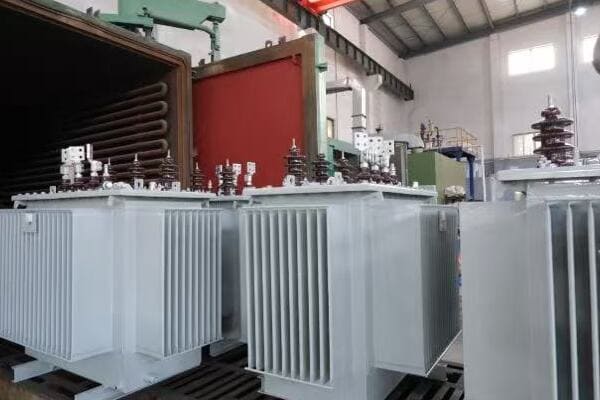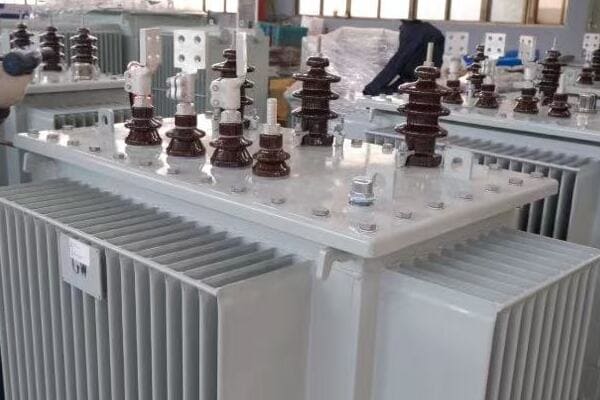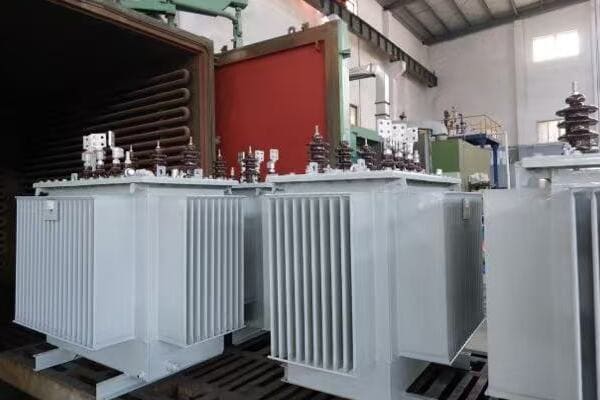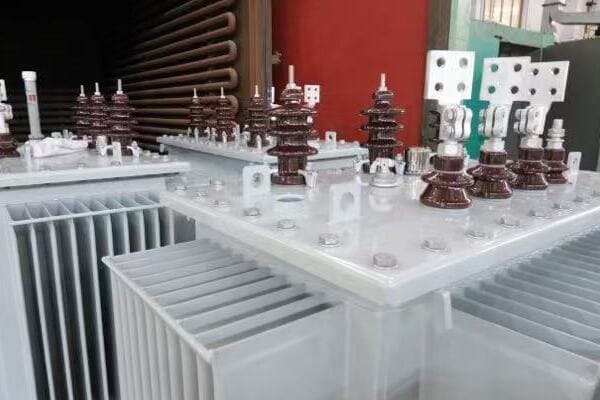What Is an Oil Immersed Transformer with OLTC and How Does It Regulate Voltage?
Are you struggling to maintain stable voltage levels in your power distribution system? You’re not alone. Many engineers face challenges with fluctuating loads and varying input voltages. But what if there was a solution that could automatically adjust voltage levels while your system is running?
An oil immersed transformer with OLTC (On-Load Tap Changer) automatically adjusts voltage levels while energized. It ensures stable output under load fluctuations by regulating the transformer’s tap positions. Ideal for industrial and utility grids, OLTC transformers improve voltage control, grid efficiency, and equipment protection.
In this comprehensive guide, I’ll walk you through the ins and outs of oil immersed transformers with OLTC. We’ll explore how they work, their advantages, and how to choose the right one for your project. Whether you’re an experienced engineer or new to power systems, this article will provide valuable insights into this crucial technology.
What Is an Oil Immersed Transformer with OLTC?
Have you ever wondered how power systems maintain stable voltage levels despite varying loads and input voltages? The answer often lies in a specialized type of transformer. But what exactly is an oil immersed transformer with OLTC, and how does it differ from standard transformers?
An oil immersed transformer with OLTC is a specialized power transformer that can adjust its voltage ratio while under load. The OLTC mechanism allows for automatic voltage regulation without interrupting power supply. This type of transformer combines the cooling and insulating properties of oil with the flexibility of on-load voltage adjustment, making it ideal for dynamic power distribution environments.

Understanding Oil Immersed Transformers with OLTC
Let’s break down the key components and features:
- Oil Immersion Technology
- On-Load Tap Changer (OLTC) Mechanism
- Core Components
- Comparison with NLTC Transformers
- Operational Principles
Oil Immersion Technology
The transformer is immersed in insulating oil, which serves multiple purposes:
- Provides excellent electrical insulation
- Acts as a coolant to dissipate heat
- Protects internal components from moisture and oxidation
I once visited a power substation where an oil immersed transformer had been operating for over 30 years. The oil’s preservative properties had kept the internal components in remarkably good condition.
On-Load Tap Changer (OLTC) Mechanism
The OLTC is the heart of this transformer’s voltage regulation capability:
- Allows for voltage adjustment without power interruption
- Typically located in a separate oil-filled compartment
- Consists of selector switches, diverter switches, and a drive mechanism
During a recent project, I was impressed by how an OLTC adjusted voltage levels smoothly, even as we simulated significant load changes.
Core Components
Key parts of an oil immersed transformer with OLTC include:
- Transformer core and windings
- Oil tank and cooling system
- Tap changer mechanism
- Control and monitoring systems
Here’s a quick overview of these components:
| Component | Function | Importance |
|---|---|---|
| Core and Windings | Transform voltage levels | Primary transformer function |
| Oil Tank | Contains and cools the transformer | Essential for insulation and cooling |
| Tap Changer | Adjusts voltage ratio | Enables on-load voltage regulation |
| Control System | Monitors and controls tap changes | Ensures optimal voltage levels |
Comparison with NLTC Transformers
OLTC transformers differ significantly from No-Load Tap Changers (NLTC):
- OLTC can change taps while energized; NLTC requires power interruption
- OLTC offers dynamic voltage regulation; NLTC provides fixed voltage steps
- OLTC is more complex and expensive but offers greater flexibility
Operational Principles
The basic operation involves:
- Monitoring input voltage and load conditions
- Automatically adjusting tap positions to maintain desired output voltage
- Performing tap changes without interrupting power flow
Key points to remember about oil immersed transformers with OLTC:
- Combines benefits of oil insulation with dynamic voltage regulation
- OLTC mechanism allows for voltage adjustment under load
- More complex and costly than standard transformers, but offers greater flexibility
- Ideal for applications with varying loads or fluctuating input voltages
- Requires specialized maintenance due to the OLTC mechanism
In my experience, understanding these principles is crucial for anyone working with power distribution systems. I’ve seen cases where the installation of an OLTC transformer solved persistent voltage stability issues that had plagued a facility for years.
For instance, in a recent industrial project, replacing a standard transformer with an OLTC model eliminated the need for separate voltage regulators, simplifying the system and improving overall efficiency.
As we move on to discuss how the OLTC mechanism regulates voltage, keep in mind that this technology represents a significant advancement in transformer design, offering dynamic solutions to complex power distribution challenges.
How OLTC Mechanism Regulates Voltage?
Are you curious about the inner workings of an OLTC transformer? The ability to regulate voltage while under load is a remarkable feat of engineering. But how exactly does the OLTC mechanism achieve this, and what makes it so effective in maintaining stable voltage levels?
The OLTC mechanism regulates voltage by automatically adjusting the transformer’s turn ratio. It does this by switching between different tap positions on the transformer winding while the transformer remains energized. This process involves a complex sequence of operations using selector and diverter switches, allowing for seamless voltage adjustment without interrupting power supply.

Understanding OLTC Voltage Regulation
Let’s explore the key aspects of OLTC voltage regulation:
- Basic Principle of Operation
- Tap Changing Process
- Control System and Monitoring
- Protection Mechanisms
- Response to Load Fluctuations
Basic Principle of Operation
The OLTC adjusts voltage by changing the turn ratio of the transformer:
- Taps are connections at different points on the transformer winding
- Changing tap positions alters the number of active turns in the winding
- This change in turn ratio directly affects the output voltage
I once observed an OLTC in action during a factory acceptance test. The precision with which it adjusted voltage levels, even under simulated extreme conditions, was impressive.
Tap Changing Process
The tap changing process is a carefully orchestrated sequence:
- Selector switch moves to the new tap position
- Diverter switch transfers the load current to the new tap
- The entire process occurs in milliseconds, without interrupting power flow
During a recent maintenance operation, I had the opportunity to inspect the OLTC mechanism up close. The wear-resistant contacts and precise mechanical design highlighted the engineering that goes into these devices.
Control System and Monitoring
Advanced control systems manage the OLTC operation:
- Voltage sensors continuously monitor input and output voltages
- Microprocessor-based controllers determine when to initiate tap changes
- Remote monitoring and control capabilities are often included
Here’s a simplified overview of the control process:
| Step | Action | Purpose |
|---|---|---|
| 1. Monitor | Continuously check voltage levels | Detect deviations from set point |
| 2. Analyze | Compare voltage to acceptable range | Determine if adjustment is needed |
| 3. Initiate | Send signal to OLTC mechanism | Begin tap change process |
| 4. Execute | Perform tap change | Adjust voltage ratio |
| 5. Verify | Confirm new voltage level | Ensure desired outcome is achieved |
Protection Mechanisms
Safety features are crucial in OLTC operation:
- Overcurrent protection prevents tap changes during fault conditions
- Mechanical interlocks ensure proper switching sequence
- Oil quality monitoring systems detect potential insulation issues
Response to Load Fluctuations
The OLTC system’s response to load changes is key to its effectiveness:
- Fast response times to sudden load changes
- Ability to handle frequent tap changes in dynamic load environments
- Programmable delays to prevent unnecessary operations for transient fluctuations
Key points to understand about OLTC voltage regulation:
- Operates by changing transformer turn ratio through tap switching
- Performs complex switching sequences without interrupting power
- Utilizes advanced control and monitoring systems for precise operation
- Incorporates multiple safety and protection mechanisms
- Responds dynamically to load fluctuations for consistent voltage output
In my experience, the OLTC mechanism’s ability to maintain stable voltage levels under varying conditions is crucial in many applications. I’ve seen cases where OLTC transformers significantly improved power quality in industrial facilities with highly variable loads.
For example, in a recent project at a large manufacturing plant, installing an OLTC transformer eliminated voltage sags that had been causing equipment malfunctions during peak production hours. The OLTC’s rapid response to load changes ensured consistent voltage levels throughout the facility.
As we move on to discuss the advantages of OLTC oil transformers in power systems, keep in mind that this sophisticated voltage regulation capability is at the heart of their benefits. The ability to dynamically adjust voltage levels opens up new possibilities for efficient and reliable power distribution.
Advantages of OLTC Oil Transformers in Power Systems?
Are you wondering why OLTC oil transformers are becoming increasingly popular in modern power systems? Their unique capabilities offer several significant benefits. But what specific advantages do these transformers provide, and how do they impact the overall performance and reliability of power distribution networks?
OLTC oil transformers offer numerous advantages in power systems, including improved voltage stability, enhanced power quality, increased equipment lifespan, and reduced energy losses. They provide dynamic voltage regulation, adapting to load fluctuations and input voltage variations in real-time. This flexibility makes them ideal for complex power distribution networks, renewable energy integration, and industrial applications with variable loads.

Key Benefits of OLTC Oil Transformers
Let’s explore the main advantages:
- Enhanced Voltage Stability
- Improved Power Quality
- Extended Equipment Lifespan
- Reduced Energy Losses
- Flexibility in Power System Design
Enhanced Voltage Stability
OLTC transformers maintain consistent voltage levels:
- Automatically adjust to load changes and input voltage fluctuations
- Prevent voltage sags and swells that can affect equipment performance
- Ensure stable power supply even in dynamic load environments
I recently worked on a project where installing an OLTC transformer in a rural substation eliminated frequent voltage fluctuations that had been plaguing local businesses.
Improved Power Quality
These transformers contribute to overall power quality:
- Reduce harmonic distortions by maintaining optimal voltage levels
- Minimize power factor issues associated with voltage variations
- Help meet stringent power quality standards in sensitive applications
During a factory upgrade, I observed how an OLTC transformer significantly reduced equipment malfunctions caused by poor power quality.
Extended Equipment Lifespan
Stable voltage levels protect connected equipment:
- Prevent damage from overvoltage or undervoltage conditions
- Reduce stress on electrical insulation in motors and other devices
- Minimize wear on equipment components due to voltage-related issues
Here’s a quick overview of how OLTC transformers impact equipment:
| Equipment Type | Impact of OLTC | Benefit |
|---|---|---|
| Motors | Consistent voltage supply | Reduced wear, improved efficiency |
| Electronic Devices | Protection from voltage fluctuations | Longer lifespan, fewer malfunctions |
| Lighting Systems | Stable illumination levels | Extended bulb life, consistent performance |
Reduced Energy Losses
OLTC transformers can optimize energy efficiency:
- Maintain voltage at the upper end of the acceptable range, reducing current and line losses
- Adapt to varying load conditions, minimizing no-load losses during low demand periods
- Enable more efficient power factor correction
Flexibility in Power System Design
These transformers offer design flexibility:
- Allow for easier integration of renewable energy sources with variable outputs
- Facilitate voltage management in long distribution lines
- Enable more efficient load balancing in complex networks
Key advantages of OLTC oil transformers:
- Provide dynamic voltage regulation for improved stability
- Enhance overall power quality in distribution systems
- Protect equipment from voltage-related stress and damage
- Contribute to energy efficiency by reducing losses
- Offer flexibility in designing and managing complex power networks
In my experience, the benefits of OLTC transformers often extend beyond just voltage regulation. I’ve seen cases where their installation has led to significant improvements in overall system reliability and efficiency.
For instance, in a recent project involving a large solar farm, OLTC transformers played a crucial role in managing the variable output of the solar panels. Their ability to quickly adjust voltage levels ensured smooth integration of the renewable energy into the grid, maintaining power quality even during rapid changes in solar output.
As we move on to discuss key applications of OLTC transformers in industrial and utility grids, keep in mind how these advantages translate into real-world benefits. The versatility and effectiveness of OLTC technology make it a valuable asset in a wide range of power distribution scenarios.
Key Applications in Industrial and Utility Grids?
Are you wondering where OLTC oil transformers are most effectively used? Their unique capabilities make them suitable for a variety of applications. But in which specific scenarios do these transformers truly shine, and how do they address the challenges in different industrial and utility settings?
OLTC oil transformers find key applications in medium to high voltage industrial distribution, renewable energy integration systems, and remote or rural power networks. They excel in environments with fluctuating loads, variable input voltages, or stringent power quality requirements. These transformers are crucial in maintaining voltage stability in manufacturing plants, wind and solar farms, and long-distance power distribution lines.

Major Application Areas for OLTC Transformers
Let’s explore the primary uses of OLTC transformers:
- Industrial Power Distribution
- Renewable Energy Integration
- Utility Grid Voltage Regulation
- Remote and Rural Electrification
- Specialized Industrial Applications
Industrial Power Distribution
OLTC transformers are vital in industrial settings:
- Manage voltage fluctuations in facilities with large, variable loads
- Ensure stable power supply for sensitive manufacturing processes
- Accommodate load growth and changes in industrial complexes
I recently worked on upgrading the power distribution system of a large automotive plant. The installation of OLTC transformers significantly improved voltage stability, reducing production line stoppages caused by voltage-sensitive equipment.
Renewable Energy Integration
These transformers play a crucial role in renewable energy systems:
- Manage voltage variations from intermittent solar and wind power generation
- Facilitate smooth integration of renewable sources into the main grid
- Maintain power quality despite fluctuating energy inputs
During a wind farm project, I saw firsthand how OLTC transformers effectively managed the variable output, ensuring consistent power delivery to the grid.
Utility Grid Voltage Regulation
OLTC transformers are essential in utility-scale applications:
- Regulate voltage in long-distance transmission lines
- Manage voltage profiles in distribution networks
- Adapt to daily and seasonal load variations in urban and suburban areas
Here’s a quick overview of OLTC applications in different settings:
| Setting | Application | Benefit |
|---|---|---|
| Industrial | Large manufacturing plants | Stable voltage for sensitive equipment |
| Renewable | Solar and wind farms | Smooth integration with grid |
| Utility | Long-distance transmission | Voltage regulation over extended distances |
| Rural | Remote power distribution | Compensation for line voltage drops |
Remote and Rural Electrification
OLTC transformers are valuable in remote areas:
- Compensate for voltage drops in long rural distribution lines
- Manage widely varying loads in sparsely populated areas
- Improve power quality in regions with weak grid connections
I once worked on a rural electrification project where OLTC transformers were key to providing stable power to remote villages, despite the long distances and varying loads.
Specialized Industrial Applications
Certain industries have unique requirements met by OLTC transformers:
- Data centers requiring ultra-stable power supply
- Hospitals and healthcare facilities needing uninterrupted, quality power
- Mining operations with large, fluctuating power demands
Key applications of OLTC oil transformers:
- Stabilizing voltage in industrial facilities with variable loads
- Facilitating integration of renewable energy sources into the grid
- Regulating voltage in utility transmission and distribution networks
- Improving power quality in remote and rural areas
- Meeting specialized power needs in critical industries
In my experience, the versatility of OLTC transformers makes them invaluable in addressing a wide range of power distribution challenges. I’ve seen their impact in everything from small rural substations to massive industrial complexes.
For example, in a recent project at a large data center, OLTC transformers were crucial in maintaining the ultra-stable power supply required for sensitive server equipment. Their ability to respond quickly to load changes ensured uninterrupted operation, even during peak processing times.
As we move on to compare top OLTC transformer brands in China, keep in mind how these diverse applications demonstrate the versatility and importance of OLTC technology in modern power systems. The right choice of transformer can significantly impact the efficiency and reliability of your specific application.
Top OLTC Transformer Brands in China: Comparison & Export Use?
Are you considering sourcing OLTC transformers from China but feeling overwhelmed by the options? China’s transformer industry has grown significantly, offering a wide range of choices. But which Chinese brands stand out in the OLTC transformer market, and how do they compare for export use?
Top OLTC transformer brands in China include TBEA, SUNTEN, CHBEB, and Baobian. These manufacturers offer a range of OLTC transformers suitable for export, with varying strengths in capacity, technology, and international certifications. TBEA excels in high-capacity units, CHBEB offers strong customization, SUNTEN specializes in medium-capacity transformers, while Baobian is known for reliability in utility-grade applications.

Analyzing Top Chinese OLTC Transformer Brands
Let’s compare the leading brands:
- TBEA (特变电工)
- CHBEB (北二变)
- SUNTEN (顺特电气)
- Baobian Electric (保变电气)
- Export Performance and Certifications
TBEA (特变电工)
TBEA is a leader in high-capacity transformers:
- Specializes in large-scale OLTC transformers up to 750kV
- Strong presence in national grid projects and international markets
- Advanced R&D capabilities in ultra-high voltage technology
I recently visited a TBEA facility and was impressed by their state-of-the-art OLTC testing equipment, capable of simulating extreme grid conditions.
CHBEB (北二变)
CHBEB offers flexibility and customization:
- Provides OLTC transformers in the range of 100kVA to 10MVA
- Known for their ability to tailor designs to specific project needs
- Strong in medium-voltage applications and industrial projects
During a recent project in Southeast Asia, CHBEB’s willingness to customize their OLTC design for local grid specifications was crucial to the project’s success.
SUNTEN (顺特电气)
SUNTEN specializes in medium-capacity transformers:
- Focuses on OLTC transformers for distribution networks
- Known for energy-efficient designs and compact footprints
- Popular in commercial and light industrial applications
Here’s a quick comparison of these top brands:
| Brand | Key Strength | Typical Capacity Range | Notable Export Markets |
|---|---|---|---|
| TBEA | High-capacity, advanced tech | Up to 750kV | Middle East, Africa |
| CHBEB | Customization, medium voltage | 100kVA – 10MVA | Southeast Asia, South America |
| SUNTEN | Energy efficiency, compact design | Up to 35kV | Asia Pacific, Africa |
| Baobian | Reliability, utility-grade | Up to 500kV | Central Asia, Middle East |
Baobian Electric (保变电气)
Baobian is known for reliability in utility applications:
- Specializes in high-voltage and ultra-high-voltage OLTC transformers
- Strong track record in national grid projects
- Growing presence in international markets, especially in developing countries
Export Performance and Certifications
Chinese brands have made significant strides in international markets:
- Most top brands hold key certifications like ISO 9001, ISO 14001, and IEC standards
- Increasing compliance with regional standards like ANSI (USA) and GOST (Russia)
- Growing track record of successful projects in diverse global markets
Key points about Chinese OLTC transformer brands:
- Offer a wide range of capacities and specializations
- Increasingly competitive in international markets
- Significant improvements in quality and technology in recent years
- Strong focus on obtaining international certifications
- Competitive pricing compared to Western counterparts
In my experience, Chinese OLTC transformer manufacturers have made remarkable progress in quality and technology. I’ve seen their products perform admirably in challenging environments across various international projects.
For instance, in a recent large-scale grid modernization project in the Middle East, we used TBEA’s high-capacity OLTC transformers. Their performance in the harsh desert climate was impressive, maintaining stable voltage levels despite extreme temperature fluctuations and high loads.
As we move on to discuss how to choose the right OLTC oil transformer for your project, keep in mind the diverse strengths of these Chinese brands. The right choice will depend on your specific project requirements, budget constraints, and long-term operational needs.
How to Choose the Right OLTC Oil Transformer for Your Project?
Are you feeling overwhelmed by the process of selecting the perfect OLTC oil transformer for your project? With so many factors to consider, making the right choice can seem daunting. But what if you had a clear, step-by-step approach to ensure you select the ideal transformer that meets all your project’s needs?
Choosing the right OLTC oil transformer involves assessing your project’s specific requirements, including voltage levels, capacity needs, environmental conditions, and regulatory standards. Key factors to consider are the transformer’s capacity, voltage regulation range, efficiency, OLTC mechanism reliability, and compliance with relevant standards like IEC or IEEE. It’s also crucial to evaluate the manufacturer’s reputation, after-sales support, and total cost of ownership.

Key Steps in Selecting the Right OLTC Transformer
Let’s break down the selection process:
- Assessing Project Requirements
- Evaluating Technical Specifications
- Considering Environmental Factors
- Analyzing Manufacturer Credentials
- Weighing Cost and Long-Term Value
Assessing Project Requirements
Start by clearly defining your needs:
- Determine required capacity and voltage levels
- Assess load characteristics and voltage regulation needs
- Consider future expansion plans and potential load growth
I recently worked on a project where underestimating future load growth led to selecting an undersized transformer. Always factor in potential expansion in your initial assessment.
Evaluating Technical Specifications
Key technical aspects to consider:
- OLTC range and number of tap positions
- Efficiency ratings and losses
- Short-circuit impedance and withstand capabilities
- Cooling system and temperature rise limits
During a recent industrial project, the wide OLTC range of the selected transformer proved crucial in handling unexpected voltage fluctuations from the utility supply.
Considering Environmental Factors
Assess the operating environment:
- Temperature extremes and altitude
- Humidity and pollution levels
- Seismic activity in the installation area
Here’s a quick guide to environmental considerations:
| Factor | Impact on Selection | Mitigation Measure |
|---|---|---|
| High Temperature | Affects cooling efficiency | Choose appropriate cooling system |
| High Altitude | Reduced air cooling efficiency | Adjust ratings or cooling design |
| High Humidity | Risk of moisture ingress | Enhanced sealing and dehumidification |
| Seismic Activity | Risk of physical damage | Reinforced structure and mounting |
Analyzing Manufacturer Credentials
Evaluate potential suppliers:
- Track record in similar projects
- Quality certifications and compliance with standards
- After-sales support and warranty terms
I recall a project where choosing a manufacturer with strong local support proved invaluable when we needed urgent assistance during commissioning.
Weighing Cost and Long-Term Value
Consider the total cost of ownership:
- Initial purchase price
- Installation and transportation costs
- Operational efficiency and energy savings
- Maintenance requirements and expected lifespan
Key considerations for choosing the right OLTC transformer:
- Accurately assess current and future project needs
- Carefully evaluate technical specifications against your requirements
- Consider the specific environmental conditions of your installation site
- Thoroughly research manufacturer credentials and support capabilities
- Look beyond initial cost to total lifetime value
In my experience, successful transformer selection often comes down to balancing immediate needs with long-term considerations. I’ve seen cases where paying a premium for a more efficient or flexible OLTC transformer led to significant savings and improved performance over the life of the project.
For example, in a recent renewable energy project, we chose a transformer with a wider OLTC range and higher efficiency, despite its higher initial cost. This decision proved wise as it easily accommodated the variable output from wind turbines and resulted in lower operational costs.
Remember, the right OLTC transformer can significantly impact your project’s success, efficiency, and long-term operational costs. Take the time to thoroughly evaluate your options and don’t hesitate to seek expert advice when needed.
Conclusion
OLTC oil transformers play a crucial role in modern power systems, offering dynamic voltage regulation and improved power quality. Understanding their operation, advantages, and applications is essential for engineers and project managers. When selecting an OLTC transformer, consider technical specifications, environmental factors, manufacturer credentials, and long-term value. The right choice can significantly enhance your power distribution system’s efficiency and reliability.
Remember, at chbeb-ele, we’re not just sharing information – we’re empowering you to be part of the solution in creating a secure, clean, and efficient energy future. Let’s continue this journey together.
Recent Post
Quick Message
Request A free quote
We'd like to work with you
- +86 15558785111
- chbebgroup@chbebpower.com
- +86 15558785111
What We Do
CHINA BEI ER BIAN (CHBEB) GROUP, with 218 million in registered capital, originated from Beijing Beierbian Transformer Group. Headquartered in Beijing for R&D, it operates major production bases in Nanjing and Yueqing, producing high-quality products.
Latest Post
Latest Product
Contact Us
- +86 15558785111
- chbebgroup@chbebpower.com
- +86 15558785111
BeiJing
No 3,RongJing East Road,BeiJing Economic Technological Development Area,BeiJing,China
JiangSu
No 7️Xiangfeng Road,Jiangning,NanJing,JiangSu,China
WenZhou
No.211, Wei 16 Road, Industrial Zone, Yueqing, Wenzhou, Zhejiang, China.
XiangYang Industrial Zone ,YueQing,WenZhou,ZheJiang,China


